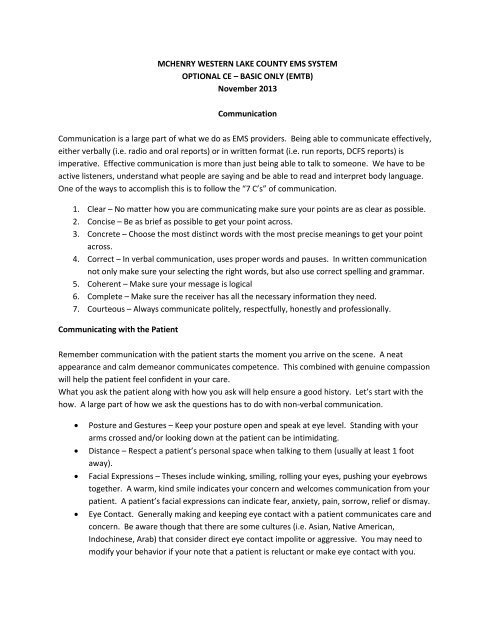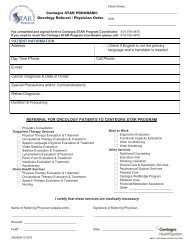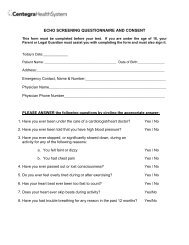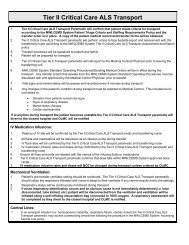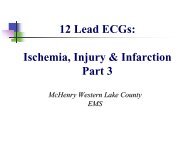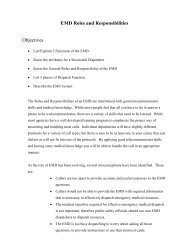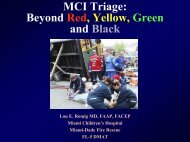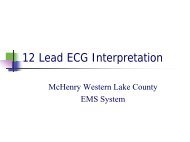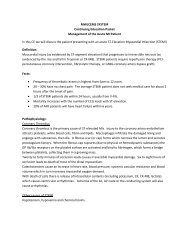Communication - Centegra Health System
Communication - Centegra Health System
Communication - Centegra Health System
You also want an ePaper? Increase the reach of your titles
YUMPU automatically turns print PDFs into web optimized ePapers that Google loves.
MCHENRY WESTERN LAKE COUNTY EMS SYSTEMOPTIONAL CE – BASIC ONLY (EMTB)November 2013<strong>Communication</strong><strong>Communication</strong> is a large part of what we do as EMS providers. Being able to communicate effectively,either verbally (i.e. radio and oral reports) or in written format (i.e. run reports, DCFS reports) isimperative. Effective communication is more than just being able to talk to someone. We have to beactive listeners, understand what people are saying and be able to read and interpret body language.One of the ways to accomplish this is to follow the “7 C’s” of communication.1. Clear – No matter how you are communicating make sure your points are as clear as possible.2. Concise – Be as brief as possible to get your point across.3. Concrete – Choose the most distinct words with the most precise meanings to get your pointacross.4. Correct – In verbal communication, uses proper words and pauses. In written communicationnot only make sure your selecting the right words, but also use correct spelling and grammar.5. Coherent – Make sure your message is logical6. Complete – Make sure the receiver has all the necessary information they need.7. Courteous – Always communicate politely, respectfully, honestly and professionally.Communicating with the PatientRemember communication with the patient starts the moment you arrive on the scene. A neatappearance and calm demeanor communicates competence. This combined with genuine compassionwill help the patient feel confident in your care.What you ask the patient along with how you ask will help ensure a good history. Let’s start with thehow. A large part of how we ask the questions has to do with non-verbal communication.• Posture and Gestures – Keep your posture open and speak at eye level. Standing with yourarms crossed and/or looking down at the patient can be intimidating.• Distance – Respect a patient’s personal space when talking to them (usually at least 1 footaway).• Facial Expressions – Theses include winking, smiling, rolling your eyes, pushing your eyebrowstogether. A warm, kind smile indicates your concern and welcomes communication from yourpatient. A patient’s facial expressions can indicate fear, anxiety, pain, sorrow, relief or dismay.• Eye Contact. Generally making and keeping eye contact with a patient communicates care andconcern. Be aware though that there are some cultures (i.e. Asian, Native American,Indochinese, Arab) that consider direct eye contact impolite or aggressive. You may need tomodify your behavior if your note that a patient is reluctant or make eye contact with you.
Most patients are more than willing to talk to you and answer your questions. It is important to uselanguage they will understand. Avoid the use of complicated and technical medical terms. Points toremember are:Only ask one question at a timeAvoid using leading or biased questionsDo not interrupt the patient as they are talkingRemain impartial and non-judgmentalDo not provide false assuranceCommunicating with Medical ControlYou are the eyes of medical control out in the field. It is only by your report that they will have a clearpicture of the patient’s condition. Therefore it is important that your radio report be organized, conciseand pertinent. By always following the same format it decreases the likelihood of leaving out somethingimportant. Radio reports should follow the following format:Identification: Hospital being contacted; EMS provider agency and unit #Age, genderLevel of consciousness and orientationChief complaint, nature of call and prehospital impression including perceived acuity/severity.Chief complaint (OPQRST); life-threats; degree of distressAssociated complaintsPertinent negatives/denialsHistoryAllergiesMedications (current); compliance; time and amount of last dose if applicablePertinent past medical historyLast oral intake; last menstrual cycle is indicated.Events leading up to present illness or injury: mechanism of injury for injury; pertinent sceneinformation; environmental factors; social situation.Assessment FindingsPhysical exam including pertinent positive and negative findingsVital SignsSkin color, temperature and moisturePulse oximetry readingCapnography reading and waveform if indicated and availableECG interpretation;Blood glucoseGCSTreatments initiated prior to hospital contact and patient response to treatmentDestination Hospital and ETA
There may be times when due to the patient’s condition and resources available an abbreviated reportwill be necessary. This should include at a minimum:Hospital contacted, EMS agency, receiving hospital and ETAIdentify the nature of the situation and how it meets criteria for an abbreviated reportPatient age, gender, level of consciousness and orientationChief complaint and brief history of injury or illnessInitial impressionApparent life-threatsVital signs and major interventions/resuscitation providedTransfer of CareUpon arrival to the hospital and transfer of care to the nurse you will deliver an oral report. The oralreport should summarize the information you already gave over the radio along with any updatedinformation. Key items to include are:The patient’s chief complaintAny changes in the patient’s condition since report was called.The patient’s vital signs taken enrouteTreatment given to the patient and their responsePertinent history not given in the earlier report.
McHenry Western Lake County EMS <strong>System</strong>OPTIONAL CE – BASIC ONLY (EMTB)November 2013<strong>Communication</strong>Name: __________________________________ Dept: _________________________________Date:__________________________1 – 7 List and define the 7 C’s of communication.1. _________________________________________________________________________2. _________________________________________________________________________3. _________________________________________________________________________4. _________________________________________________________________________5. _________________________________________________________________________6. _________________________________________________________________________7. _________________________________________________________________________8. List 4 important aspects of non-verbal communication:A. ___________________________________________________B. ___________________________________________________C. ___________________________________________________D. ___________________________________________________9. To instill confidence in your patient it is important to speak to them in only complicated medicalterminology. True False10. List the format you will follow when giving a radio report.
11. When is it OK to use an abbreviated medical report on the radio?12. Key items to include in your report to the nurse you transfer care to are:A. _______________________________________________B. _______________________________________________C. _______________________________________________D. _______________________________________________E. _______________________________________________


